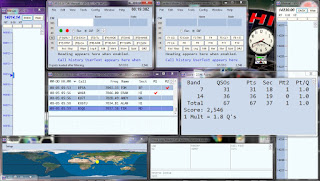The last weekend of August brings
a myriad of radiosport contest events sprinkled around a 48 hour operating period, opening with the Hawaiian
QSO Party (HQP) beginning @04:00z Friday evening (9pm, California time).
I didn't find out until Saturday morning that the Hawaiian area was hassled
by ravaging storms. Later in the contest period, the entire planet was deluged by a solar-induced geomagnetic storm.
While the solar cycle may be at near minimum, that does not preclude solar "BELCHES" creating devastating (altho temporary) noise storms, or even brief blackouts. Instead, radio blackouts were replaced by internet dropouts on the Fallbrook end of the NX6T remote connection.
 |
| N X 6 T - STN-1 |
filter combination, specifically to process the laptop audio coming in remotely from NX6T
(in Fallbrook) by way of the RCForb radio-control software on both ends of the connection.
 |
| Hawaiian County Multipliers |
2nd & 3rd place (for California)
in the Hawaiian QSO Party (HQP).
I was hoping this year would allow
me to surpass those efforts.
Oh well, maybe next year.
[CLICK HERE] for HQP
contest rules.
There were an additional handful
of contest events during this last weekend of August, including:
- The Ohio QSO Party [CLICK HERE] to see the rules.
- The Kansas QSO Party [CLICK HERE] to see the rules.
- The SCC RTTY Contest [CLICK HERE] to see the rules.
- The W/VE Islands Contest [CLICK HERE] to see the rules.
- The YO DX Contest [CLICK HERE] to see the rules.
time for the QSO parties or the SCC RTTY Gig. Nevertheless there was enough variety of contest conditions to give the Autek and MFJ filters good exercise.
 |
| OHQP Ending Screen |
My BEEF with OHQP is the short contest period (only 12 hours) and the relatively poor turnout of Ohioans for their own QSO Party.
As a Californian I am spoiled by the HEAVY turnout for the annual California QSO Party (CQP), meaning that I have high expectations for other state QSO parties and am easily disappointed.
 |
| KSQP Ending Screen |
that I am singling out ONLY Ohioan amateur stations; the KSQP and HQP events showed little activity as well.
This is always my frustration in QSO parties - not enough stations play in
the QSO party for their own state.
If you are looking to add contest
award certificates to your wall, state QSO parties are an easy way to accomplish that goal.
 |
| SCC RTTY Ending Screen |
on the WA7BNM Contest calendar,
I learned these stations were running the SCC RTTY HF Championship.
By 07:30Z I ran out of SCC stations
to work. Needing sleep, I shut things down. At 14:00z the SCC GiG was over, with 31 QSOs in the log.
Getting back on the air at 15:00z there was 5 hours left in the KSQP and 13 hours left for the Hawaiian QSO party.
Did YOU play around in last weekend's radiosport events?
Is WQ6X in YOUR Log?






























